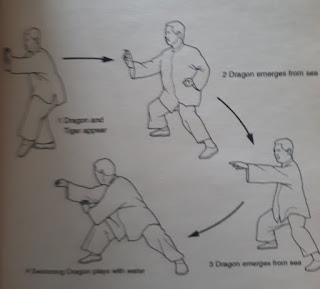The Reverse Crescent Kick in Taijiquan

Hi, blog readers.
As suggested by Travelling Lakan in our Martial Arts Forums group on G+ I write this weekend's post about the reverse crescent kick as we find it in Taijiquan. I admit that I have not seen a spinning version of this kick in Tai Chi forms, but using the principles of Taiji technique I have constructed a spinning kick for us to use in this discussion.
I was not able to get examples from the internet of this particular kick off the internet, so I made videos under the strict supervision of Master Patrys. She supervises all of my Saturday workouts and makes sure that I do not slack off when training. :D
I have not seen this kick in Shotokan before. To give you an idea of what a reverse crescent kick is I can use Ryu from the Street Fighter game series as an example. Ryu has a special attack called the "Tatsu Maki Senpuu Kyaku". I have yet to ask my Japanese friends for an accurate translation, but we gamers got to know it as the "Hurricane Kick" or the "Helicopter Kick".
Back in the 90's I thought Ryu's spinning off like that to be impossible, but the videos we find on the internet showing 720 and 1080 spinning kicks being performed show us that martial artists can push their limits when they are really intent on doing so.
Where the normal reverse crescent kick is well known without any aerobatics or acrobatics are the arts of Capoeira and Taekwondo.



I don't know Capoeira, so I won't elaborate on its technique.
In Taekwondo, however, this kick has a non-spinning version that can be used as a parry to sweep attacking arms or legs out of the way by using the kicking leg or an attack that strikes with the outer edge of the kicking foot.
The spinning version in Taekwondo uses a sharp twist of the shoulders- about 270 degrees and pushing beyond that- which in turn pulls the hips into rotation that in turn propels the kicking leg into a devastating whiplash effect. The rotation is sharp enough to sufficiently power the kick even if the supporting foot leaves the ground.
I have seen the reverse crescent kick in only one Taiji form before and it looks something like this:
Kung fu in general, and Taijiquan being no exception, launches a kick only after the supporting foot has been turned into position and planted. Turning the foot outward sets you up for front kicks, roundhouse kicks or just a straightforward lunge. Turning inward prepares you to execute spinning kicks or spinning attacks.
Taijiquan's attacks can be done on a slippery floor without falling because momentum is not allowed to run away with you. Weight is usually shifted to a place only when the foot is already there to receive it. This is a lot different from Karate.
This is why the kick starts with the cross-step placing the supporting foot in position before the kick flies out. The form has the hands slapping the kicking leg like what I am doing in the video. The reason for this is unfortunately not explained by Paul Crompton in his book. I suspect that it has something to do with disarming an attacker that uses a spear or a staff, though.
The upper body remains right on top of the supporting leg. The qi is lowered into the abdominal area to which Taiji snobs refer as the tan tien and doing this creates a feeling of the supporting leg being hard and very heavy while the rest of the body on top of it feels light and empty.
Hitting a bag from this posture with an explosive kick will reveal that the body feels unaffected by the kick and remains firmly in place while the bag buckles with a resounding thud.
Taijiquan is a martial art of Wudang Temple along with Xingyiquan and Baguazhang.
The latter two arts have techniques that involve the body rotating. This rotation starts from the feet. From horse stance the feet rotate to twist the horse stance into a cross-legged stance. In Shaolin a cross legged stance reached by doing this is known as a unicorn step and counterattacks can follow from that position by just unwinding the stance again into a horse stance or bow stance.
The same happens in Wudang's martial arts.
The tension built by this twsited posture can also be released by simply letting one of the legs shoot into a kick. In this case it is a reverse crescent kick. Unlike Taekwondo students, however, I do not let the momentum lift my body off the ground, though. Even if I do this kick at full speed- I still maintain my stability by keeping my qi lowered. Doing this will also work against a bag the same way as the previous kick, except that this kick is a lot more powerful due to the added momentum from the rotation.
That is it for this weekend's post.
I hope everyone has a wonderful week ahead. I am starting mine in a court about 350 km from my home town. The joys of work... :)


Comments
Post a Comment